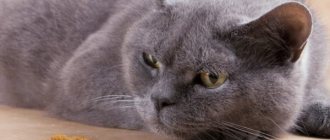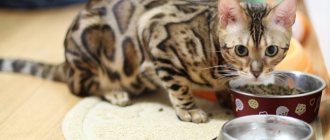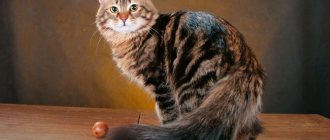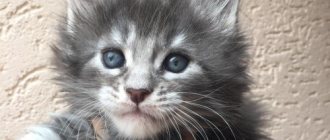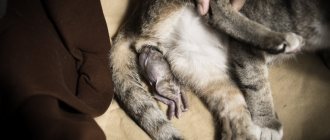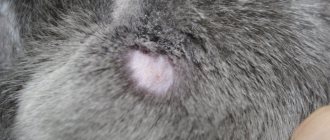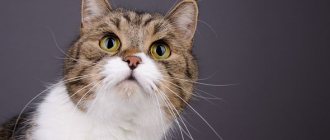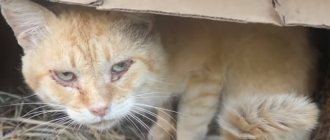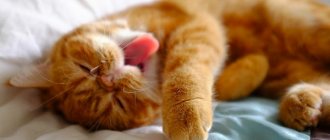- Cats
The Siberian cat is a natural Russian cat breed that belongs to the group of European forest cats. The natural habitat of the ancient relatives of this breed was the expanses of Siberia, which explains their appearance - these are large and very fluffy cats with excellent hunting acumen.
Natural or native breeds are mysterious because... it is impossible to accurately identify their roots. If we talk about the Siberian cat, we mean that this is the result of crossing forest cats with pets that came along with their owners.
The Russian Siberian breed has gained popularity in different parts of the world, although the adoption of a standard and the approval of typical properties characteristic of this type of cat began not so long ago (in the 90s).
History of the Siberian breed
The Siberian cat has ancestors from Taiga. It is known that the first Siberian cats were immigrants from Asia. They were aboriginal cats who helped the Siberian ones get such a thick fur coat so as not to freeze in the harsh Russian climate. Then the pet was called the Bukhara cat. Siberian cats are also mentioned in folklore: this is the famous scientist cat of Pushkin and the pet of Baba Yaga. More accurate information about Siberians appeared much later.
This is interesting! The breed owes its appearance to the severe Siberian frosts, and its habits to forest cats.
Initially, they wanted to christen the breed Moscow, but in the end they named it in honor of their homeland - Cis-Ural Siberia. And although the basis of the population was precisely Moscow and Leningrad cats, the name stuck. Soon Siberian cats spread throughout Russia. They were the ones who helped fight Leningrad mice and rats during World War II. After breaking the blockade, two echelons of furry defenders were brought into the city and distributed on the streets.
The Siberian cat breed officially began to exist in the 80s of the last century, when the felinological society was born in the CIS (then the USSR). Almost immediately, standards for the Siberian breed were formed. An example was a cat named Roman. Today, oddly enough, Siberian cats live mostly abroad.
Siberian cat: characteristics of the breed
You can recognize a Siberian cat by its muscular body with strong bones. By standard, she has a firm belly and a massive neck. The shoulders are lowered and the back appears higher, the chest is wide. The paws are usually powerful and large, but the animal moves gracefully. The head is round, medium or large. The ears of the Siberian breed are slightly inclined. Tassels are welcome. The tail is long and fluffy.
The eyes of Siberians are usually yellow or green and round in shape. The muzzle is elongated, with expressive cheekbones, a wide forehead and a powerful chin. The coat is long and stiff, with a double undercoat that repels water and dirt. The Siberian cat has a different collar on its neck.
Important! Siberian cats weigh on average 6-10 kg, and male cats from 5 to 6 kg. This is one of the largest cat breeds, second only to the Norwegian Forest and Maine Coons.
The Siberian breed holds the record for the number of colors. The general texture consists of black, white, gray and red, with additional blue and beige. There are individuals with a uniform color in two colors (black and white). Tortoiseshell coloration, that is, a solid combination of shades, is usually observed only in females. In cats, this coat color may indicate a genetic disorder.
Tabby color is the most popular color for this breed. It is a pattern of dark spots and makes the cat look like a tiger. The difference between this color is the clear letter M on the forehead. A tabby Siberian will have a light chin and dark rings on its paws and tail.
Smoky color - light roots and dark tips - is less common among representatives of the Siberian breed. The beauty of the color is that when motionless the cat appears dark, but when it moves, the light roots of the fur are visible.
This is interesting! Siberian cats with Siamese color or color point (the tip of the tail, ears and muzzle are dark, and the rest of the fur is light) were isolated separately. This breed is called Neva Masquerade.
Colors not allowed:
- Abyssinian;
- point;
- lilac.
It is worth noting that Siberian kittens take a very long time to develop. They reach average size only by 5 years. This is a great option for those who like to spend longer with their kids.
Choosing a Siberian kitten
Having decided to get a Siberian kitten, the future owner should take the choice of one very seriously. The cost is determined by the breed of the kitten, its color, pedigree and class. There are only three classes, and representatives of the first of them, which allow participation in exhibitions, are worth more than the rest. Each breed also has its own system of colors, for example, the solid black color in the British and Persian breeds is one of the oldest varieties and is considered especially noble.
Having decided on the price, you can choose the kitten itself. After examining the brood, do not choose the most aggressive one, but you should not take the most timid one either - there is a risk of predisposition to stress, emotional and physical difficulties in the future . Plus, timid kittens tend to have weak immunity and are more susceptible to disease.
Since the character of the kitten and its condition largely depend on the mother cat, be sure to get to know her. So, if the mother looks unkempt, most likely the kittens did not receive proper care. Externally, regardless of the breed, the kitten should look clean and well-groomed, be active and curious. Don't forget to also ask about his vaccinations and what care he needs.
In addition to the condition of the kitten, its appearance is also important. Some people want their kitten to be black, some only want bright red, while others generally like exclusively white and fluffy kittens. Siberian cats differ from other breeds in the richest choice of color options; you just need to remember such amazing creatures as the Neva Masquerade. If you are used to the fact that native cats have green eyes and yellow eyes, you will be amazed to see their blue eyes.
The solid black color, which is considered mystical, also has its own magic. Although everything is not so simple here - at different times, the black color of wool was interpreted differently. Revered by the ancient Phoenicians, he was persecuted in the Middle Ages. A couple of centuries later, a new misfortune came - the black cat (in whole or in parts) was considered a universal remedy for almost any disease or misfortune. But in reality, black color indicates the intensity of pigment metabolism and a high level of protective substances, good health and good immunity.
Character and habits
Such cats are full of dignity and calm. The Siberian cat has a free character. She knows how to adapt and cope with changes in environment without stress. This breed is somewhat similar to dogs, because they are just as loyal and display watchdog habits. They can live both in a house and in an apartment, but they will have to make a “back” exit so that the cat can walk at his own discretion. You can train such a cat, but not by force.
This is interesting! Siberian cats are ideal hunters. You can let your pet out in the morning and wait until the evening with some prey in its mouth.
Siberians do not cuddle with their owners, although they love children - these cats become truly excellent nannies. Both the owners of such cats and experts talk about the unique peacefulness of Siberians towards people. Even if a child pulls the cat's tail, it will either leave or not pay attention. It is difficult to anger a cat to the point of displaying anger, because the breed is distinguished by its balance. Siberian cats are affectionate, but in moderation. They never become boring or intrusive.
They prefer to lead, but never offend other animals. They will try to establish peaceful relations, but hunting instincts may take over if there is a small rodent or rabbit in the house. It is impossible to confuse or frighten a Siberian. He fearlessly perceives noise, large animals, and strangers. Watchdog habits will tell the cat not to be scared, but to warn the owner.
Important! The Russian Siberian cat loves to give its owners “gifts” in the form of mice and other prey.
Siberians are independent: they will come running when called, but if not necessary, they will sneak away for a walk. Possessing good intelligence, Siberian cats remember their name and respond only to it. If your pet does not have access to the street, you need to support his active lifestyle, buy toys and come up with real distances with obstacles. Siberians can distinguish a game from a real danger and will first think about what to do.
The breed has clear sanguine traits. They all appear in moderation. In the family, they single out the owner and obey only him.
Colors
This breed comes in a wide variety of shades. Chocolate, Burmes and cinnamon colors are considered undesirable. White color and colorpoint is a separate subspecies - Neva Masquerade. Let’s see what the Siberian cat breed looks like in different shades in the photo.
Tortoiseshell or tabby cake
This color is presented in the form of mosaic spots, the main shades of which are cream and red. The spots should be scattered chaotically and not create patterns.
Tabby
This wild shade is presented in the form of light brown or gray stripes or spots. Thanks to this color, cats are able to camouflage well while hunting.
Smoky and silver or smokey silver
The Siberian blue cat with a silvery tint has its own special charm. Smooth transitions of gray shades should not create patterns on the body.
Gold
This noble color is presented in the form of a warm apricot shade. Golden cats usually have clear green eyes.
White
White Siberian cats are often compared to the Turkish Angora, because even their eye color can range from green to sky blue.
Bicolor
This is a combination of two shades. It can be plain with white or tortoiseshell with interesting white inserts.
Colorpoint
Point cats are presented in delicate colors with spots of various shades.
Tabby points
This shade includes dark brown, cream and tortoiseshell points.
Caring for a Siberian cat
The closer a cat lives to natural conditions, the less care it requires. The Siberian wild cat never bathed, but at the same time his luxurious coat shone and shimmered. If an animal lives in an apartment, then natural biorhythms are disrupted. Constant heat in the room provokes endless molting. Unnatural nutrition makes the coat dull and brittle. But even if everything is in order with health, your pet’s long hair is a reason for regular grooming. Otherwise, it will cover all carpets, upholstery and clothing. You need to comb your fluffy two to three times a week, and bathe it when it gets dirty. Pay special attention to the panties, neck collar and armpit area. To care for the coat, you need to purchase a special slicker brush and a set of combs.
If a Siberian cat has captured your heart, reviews will be useful to know what to pay special attention to. Usually there are problems with the toilet. It's easy to train your pet to use a litter box, but fluffy and long hair tends to spread the contents of the tray around the room. Sawdust, sand, and pieces of paper cling to it. Special fillers are a good solution, but they do not completely solve the problem, since the “pants” often get dirty with feces. So you will have to wash your furry pet regularly, at least its back part.
You need to bathe your cat using a special shampoo for long-haired breeds. Remember that it must be washed off very carefully so as not to cause irritation to the skin. Buy your pet two towels. You will wrap it in one immediately to get wet, and in the second you will dry it completely. It’s good if the shampoo contains an antistatic agent and conditioner, it’s easier to avoid tangles. In addition, you should purchase a special spray that makes combing easier.
Get your pet used to using a hair dryer. First, sort the wool with your hands, then comb it and dry it thoroughly with a stream of air. If the tangle does not give in, lightly cut it at the base (where the hairs cannot be separated), and then, using your hands and a comb, separate it completely. Completely stuck areas (glue, resin) will simply have to be cut out. Every two weeks you need to check your ears and clean them with a cotton swab. Don’t forget to also brush your pet’s teeth with a special paste.
Reproduction
Siberian cats are very sociable, so they do much better if they live in pairs. These fluffies enter puberty quite early, so at just five to six months they can surprise you with their intention to become parents. This is due to the way of life of their wild ancestors: since they could die at any moment, it was necessary to leave offspring as early as possible. By the way, these animals take excellent care of babies. The male, along with the female, takes part in caring for the offspring. Even in the wild, a pair is often created once and for life. At home, your cats will simply be in awe. Usually there are five to six kittens in a litter.
Ideal diet
An ideal diet should be balanced. If the cat does not eat certain foods, they can be replaced with others that are similar in the presence of beneficial substances.
Very often, adult animals develop intolerance to milk. In this case, instead of milk, you can give fermented milk products - kefir, sour cream, cottage cheese (but not curd mass or cheese curds).
Keeping a Siberian cat
Of course, there are some peculiarities in caring for Siberian cats.
For example:
- this breed loves daily walks and needs them even in winter;
- They also prefer to relieve themselves on the street, although it is believed that Siberians are easier to train than other breeds to use the toilet;
- It is better to feed a Siberian cat with natural food - meat, fish, eggs, with herbal supplements and vitamins;
- Siberians, in principle, do not need to trim their nails; a good quality scratching post is enough for them;
- It’s great if you can organize a corner for your pet to play and relax;
- when dirty, the cat’s ears should be wiped with an oil swab, the eyes with just a damp one;
- The health of the Siberian breed is excellent, but vaccinations as a preventive measure will not hurt.
Despite their rather long hair, Siberian cats are practically hypoallergenic.
How to care for the fur of a Siberian cat
How to care for a Siberian cat “Shubka” of this breed is a different story. Many potential owners are intimidated by caring for such luxury, but how long will it take skillfully? In autumn and spring, Siberian cats shed and need to be groomed.
To care for their fur you will need special brushes:
- slicker;
- wide flat brush;
- flea and dirt comb;
- metal comb with sparse long teeth;
- rough gloves for massage;
- a piece of suede or terry cloth.
Combing occurs in several stages:
- rare teeth – fine teeth – fine comb;
- the tail is combed out with a brush;
- Use a slicker to remove the undercoat (only during the molting period).
You should not use brushes with artificial bristles - they make the hair brittle. This breed is not afraid of water, but it is not worth bathing it often - its coat remains clean for a long time. Before bathing, the cat must be combed. Finish the bathing procedure by applying a special balm. Do not leave the animal in the sun for a long time - the color may fade.
Proper nutrition
Kittens of this breed need to be fed so that they learn to eat completely different foods. Dry food is also suitable, but it is important to ensure that your pet always has fresh water. To ensure proper nutrition and care, take care of separate plates or bowls.
Up to 3 months, the kitten is fed up to 6 times a day, gradually reducing the frequency of feeding. The adult cat's regimen involves feeding 2 times a day. In the first days, it is important to feed the baby what he ate from the previous owner, gradually adding new treats. If the kitten is light in color (white or bright red), you should not give it liver to eat - it may cause the fur to darken.
It is important that your diet includes cottage cheese, kefir, cereals, legumes, vegetables and even fruits. If you feed your baby only canned food, dry food, and even just meat, his health will be at risk of serious illness. An unambiguous criterion for proper nutrition is a happy, healthy cat with thick and lush hair.
Interesting facts about Siberian cats
- The famous politician and former President of the Russian Federation Dmitry Medvedev is a true admirer of Siberian cats. His pet, named Dorofey, even took part in one of the popular television shows.
- The fur of Siberian cats is unique in its composition. Its peculiarity is that it almost never causes an allergic reaction. Therefore, representatives of this breed are the best choice for those who want to have a pet, but are prone to allergies.
- In Tyumen there is a special “Square of Siberian cats”. There are 12 cat figures installed here. They are cast from cast iron and covered with golden paint. The monument is dedicated to the cats who protected the Leningrad Hermitage from rats during World War II. Rodents were destroying priceless museum exhibits and it was impossible to remove them. Therefore, it was decided to bring a whole squad of Siberian cats to the city. Fearless hunters, they quickly dealt with the problem and freed the Hermitage from the rat invasion.
Reviews
Vladimir Kilor
I have such a very beautiful, fluffy, affectionate cat, my children love her very much, they constantly play, tying a bundle of paper, they start running after her, she catches quickly, a wonderful mother, when she had kittens, she looked after them so interestingly, she constantly brought something, wonderful huntress, before her, when I put plasterboard on the ceiling, the mice galloped like horses and since then I haven’t heard a word when we got Mura always feels when something hurts and falls on this place, and how to say it helps heals one case was a neighbor stole a fish when he came back from fishing, it was so interesting how it ticked in his teeth with the fish, it was simply wonderful, beloved by the whole family.
Alexandra Turkevich
We have such a boy. They picked up our handsome boy at the entrance, it turned out that he was of such a breed, I can’t imagine who threw him out, and even beat him (The cat quickly got used to it and subjugated our second cat. He charms all our friends with his affection, purring, and complexion, every month he gets bigger and bigger, I wouldn’t say that he sheds, there’s not much fur at home, but he has it very beautiful.
ILUASYA Kasharova
A cat with character I love fluffy cats. I don’t know how much fluffier a Siberian can be. Siberian cats are large, their fur is soft and pleasant, they have a unique character, and they are capricious. I remember once they adopted another cat, and my Anfisa began to create such antics. There was no life for this cat. I had to give it away. By the way, those who want a cat, but are allergic to wool... a Siberian will suit you 100%. There is no protein in their fur that causes allergies. This is such a wonderful breed!!!
Maxim Malenkikh
I decided to write a review about the Siberian cat breed, since I myself have a Siberian cat named Artyom, but we call him Tyoma for short. He is almost all black, with long fur, with a characteristic “collar” and “pants”)) The cat is quite calm, but sometimes he starts running around the room, as it seems to me, after imaginary prey)) So let’s say he keeps himself in shape, does not get fat) )
